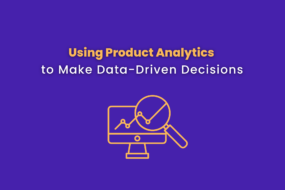

- Home
- Product
- Product Management
- Addressing Top 5 Product Commu ...
Addressing Top 5 Product Community Questions
We’ve been all ears about what the product community on different platforms has been talking about recently.
Product management has expanded as a field during the last few years. Likewise, discussions have become more common in different product management communities, such as Quora, Reddit, Facebook, etc.
Our research revealed the most pressing questions of the past year, and we’re here to answer them.
Most of the questions you’ve been asking revolved around what a day in life of a product manager looks like and what their responsibilities are. Many of you were also interested in learning more about product-related software and tools that product managers use daily.
To no longer keep you waiting, let’s take a look at the product community’s top five questions of the past year that yearn for answers.
1. What’s exciting about the future of product development?
The future of product development is destined to be exciting. The directions that it takes can already prove it.
Increasingly, product teams use data and analytics to improve user experiences and inform product decisions. Soon, a growing amount of data collected from existing products will enable companies to gain a deeper insight into the product life cycle.
This will help businesses understand how the different parts and systems work. Also, they’ll understand how they can use and misuse those parts and systems differently.
According to the report by Isaksson, O., and Eckert, the process of product development will unfold in these critical directions:
Intelligent product development
Intelligent systems will play a significant role in development processes, as tools and products will have smart parts built into them.
The systems will be able to figure out what’s wrong with themselves and take more and more control over necessary changes.
People don’t have as much of an impact on decisions as they used to. The latter makes it more important to include “human intervention touch points” throughout the product’s life cycle.
Moreover, product teams must think about how to do this directly in the product development process.
Structured and flexible processes
By 2040, a new way of structuring processes will be based on data. The ability to address the demands of people and business models requires flexibility in the product and design, production, and business processes.
As multiple development processes work together, we must find a structure that makes it easy to automate routine tasks and work well with others.
Gamification of engineering design
Real-time testing of proven models of existence is likely to become more critical when making decisions.
Instead of testing products against a fixed set of requirements based on worst-case scenarios, real-world use data will be used to simulate how products work in real-world situations.
Democratization of data
Through sensing and measuring behavior in place, it will become more accessible and easier to learn about how existing products, processes, and users work.
The amount of data available grows, and that data will be shared (called “democratization”). However, access to data will become one of the most vital parts of new product development processes. Data management is now one of the essential things that organizations do.
2. What is product management?
Product management, being a fairly new discipline, seems a bit confusing in the eyes of those trying to join it for the first time.
However, its concept is simple to grasp if you look at it from the right angle: understanding the user’s problems.
Product management starts with understanding its goal. The goal is knowing exactly what users expect to have in the product, and translating that knowledge into things and features that the teams can build.
Although technical backgrounds are undoubtedly optional for entering product management, being able to speak engineers’ language is becoming more and more critical.
Besides, it’s becoming essential for product managers to understand AI to identify innovative opportunities.
3. What does a day in life of a product
manager look like?
The majority of people on Quora were wondering about the daily responsibilities of product managers.
Some amazing facts about this role
An efficient product manager must understand every aspect of the product lifecycle, from design to deployment and delivery. PMs are the ones in the team that are the most aware of the product and its development.
Product managers hold the product vision and are in control and supervision of the team throughout the whole lifecycle of developing the product. However, in terms of the organizational structure, they work side by side with those teams rather than above them.
They can succeed in their role because they constantly present data to support their perspectives, thus, earning respect from their team members.
Despite their experience at the crossroads of technology and business, product managers aren’t responsible for building the products themselves. Although sometimes, there are exceptions, and it depends on the size of the company and the structure of some teams.
Product manager skills
When it comes to skills, according to Forbes, a great product manager is an exceptional communicator first. Communication plays a crucial role in aligning the customer’s voice with the company’s strategic vision.
It is necessary for a product manager to maintain open communication with the marketing department in order to discuss the product marketing strategy, examine the progress that has been made with the marketing activities, and evaluate the success metrics.
As can be seen, a large portion of a day in life of a product manager is communication and collaboration with the team and stakeholders. This part also involves development meetings to discuss questions and user stories, show demos, and review the team’s progress.
A product manager has some other responsibilities, including
- reviewing KPIs,
- grooming backlogs,
- responding to emails,
- monitoring customer feedback and purchasing patterns,
- monitoring product literature,
- reviewing backlogs,
- monitoring emails
After all, great product managers know their users and can motivate their colleagues to achieve their full potential.
4. What daily tools and software do product managers use?
The tools used by product managers may vary from company to company.
However, having some tools at hand is a must for a product manager to guarantee the success of the development processes. We’re talking about analytics tools, tools for tracking and analyzing customer feedback, tools for surveys, design, testing, wireframing, communication, software development, etc.

A few of the most common and practical tools are:
- UserVoice: provides a centralized view for managing customer feedback, combining sales and customer satisfaction data for informed product choices, and completing the feedback loop for internal stakeholders and external users.
- Aha!: a web-based product management software that helps teams create, prioritize, and track features and roadmaps. It also has a built-in Gantt chart for visualizing and tracking project timelines.
Leanbe: Leanbe helps you cover the entire product development lifecycle with the ultimate opportunity of having multiple data sources, advanced competitor analysis, and much more.
Research is an unavoidable part of the product manager’s life in product development. Leanbe covers the research stage completely by providing you with the opportunity to conduct competitor monitoring.Continuous monitoring of essential product characteristics allows you to go beyond a one-time competitor study. These characteristics include marketing and content strategies and campaigns, price and feature updates, user activities, etc.
The above process can provide you with the continuous discovery of new opportunities for your product. It’s a chance for you to listen to your customers and generate new and more realistic ideas.
Product managers and teams who are seeking an all-in-one and comprehensive solution often go with this one.- UserTesting.com: allows you to conduct remote, unmoderated user tests and gather feedback on your website or app.
- Beamer: a newsfeed and changelog that is simple to use for your website or application. Its purpose is to promote user interaction as well as to introduce new features and news.
- Jira: a work management application that may be used for a wide variety of use cases.
- Notion: a collaborative platform and organizational space to jot down questions, thoughts, and ideas.
- InVision: a web and mobile-based software for prototyping, collaboration, and user testing. It allows teams to create interactive wireframes, mockups, and prototypes and share them with stakeholders for feedback.
Some criteria contribute to the choice of these products, such as UI, convenience, integrations, value for profit, etc
5. Why are customer needs important for
product development?
A product tailored to the needs of its target market increases its chances of success by learning about the market’s needs.
When consumer preferences are incorporated with larger business goals, the product manager can achieve product goals and determine what measures of success are required to calculate success.
To create products that solve customer problems, businesses must first understand what customers want. Most customers know the answer to what the next big thing for your product is.
Regular conversations with your customers may not only facilitate strong relationships with them, but they may also open up new possibilities for your business.
Taking the time to gather relevant information, listening carefully while empathizing with your potential customers, carefully considering and ranking user comments, and adopting agile development practices will help you make remarkable product and business choices.




